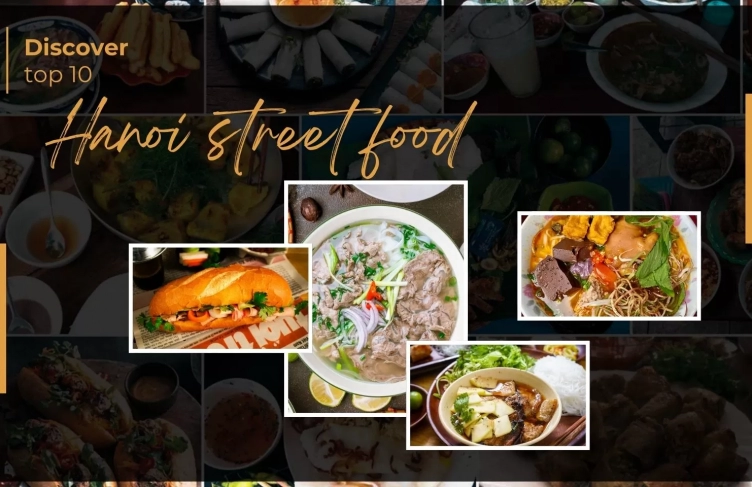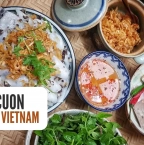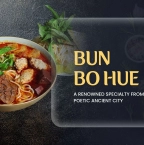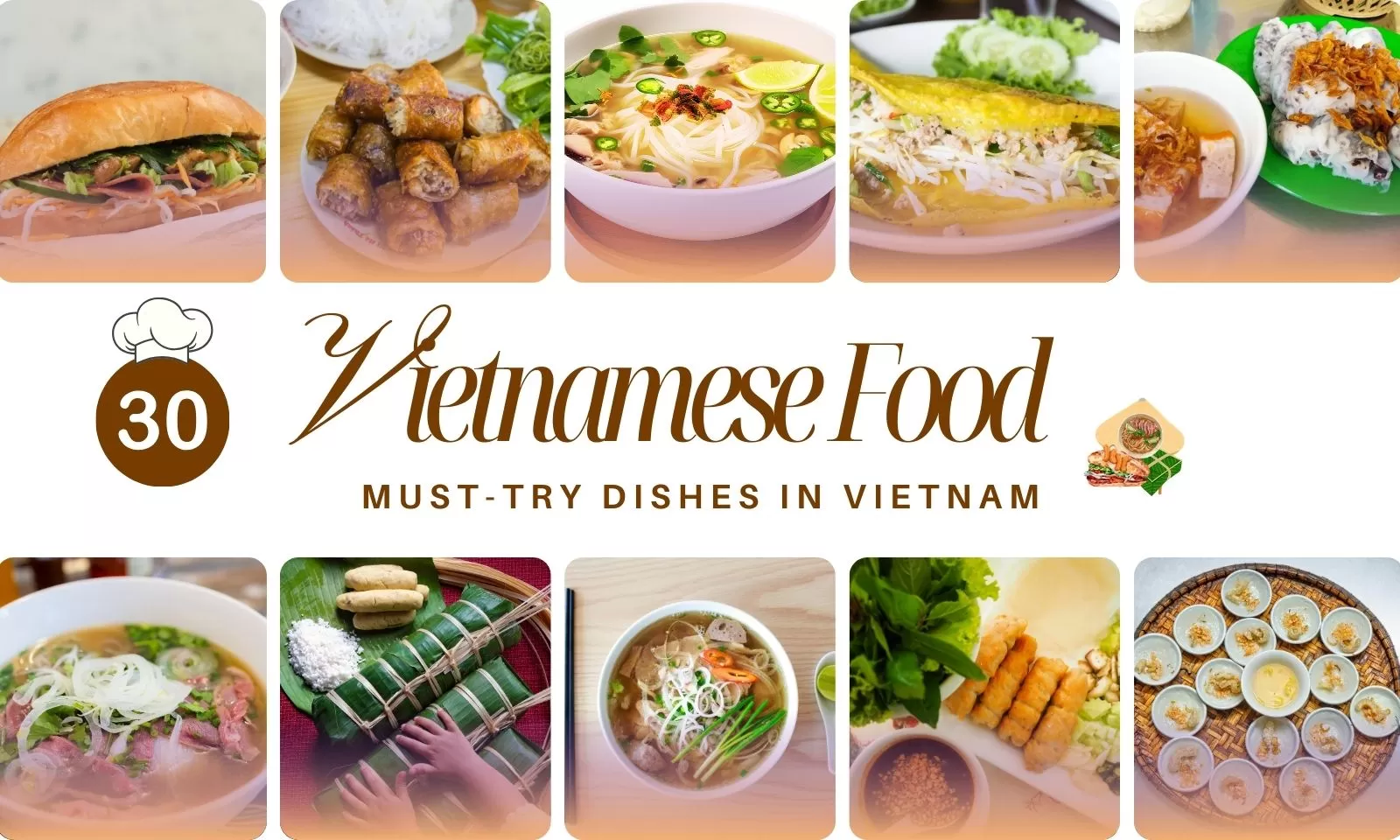
Vietnamese Food: Top 30 Must-try Dishes In Vietnam

Each country and region has its own culinary features. Vietnam cuisine is not only rich but also reflects the lifestyle of Vietnamese people and the characteristics of the tropical climate.
Discover the exquisite flavors of Vietnam through its must-try cuisine! From the iconic pho and fresh spring rolls to the fragrant bun cha and delectable banh mi, Vietnamese food is a tantalizing fusion of flavors and textures. Explore this culinary paradise with our guide to the essential dishes that capture the heart and soul of Vietnam’s rich food culture.
The article below introduces you to must-try dishes to visit Vietnam – the quintessence of Vietnamese cuisine.
Table of Contents
- Pho – Best Vietnamese food
- Banh mi - Vietnamese sandwich
- Bun cha
- Bun bo Hue
- Cha ca La Vong
- Nem ran
- Bun dau mam tom
- Bun rieu
- Bun thang
- Banh da cua
- Goi cuon
- Mi Quang
- Cao lau
- Banh cuon
- Banh xeo
- Banh beo
- Banh khot
- Com hen
- Xoi
- Com tam
- Bo kho
- Cha ruoi
- Lau (hotpot)
- Hu tieu
- Com lam
- Sup luon
- Banh canh cua
- Cha muc Ha Long
- Egg coffee
- Che - Sweet soup
Pho – Best Vietnamese food

Pho is one of the most famous and distinctive dishes in Vietnam. It’s a delicious and fragrant noodle soup that has become a culinary symbol of Vietnam. This Vietnamese food originated in Hanoi and was first served to diners in the early 20th century. Among its variations, Pho Bo (beef pho) is the most popular.
What makes pho special is the harmonious combination of flavors and textures – rich broth, delicate spices, soft yet chewy noodles and beef imbued with the essence of the broth. It consists of a flavorful pho broth made from beef bones and spices like onions, ginger and more. All of these ingredients when combined create delicious Vietnamese food that everyone wants to enjoy when they have the opportunity to travel to Vietnam.
Banh mi - Vietnamese sandwich
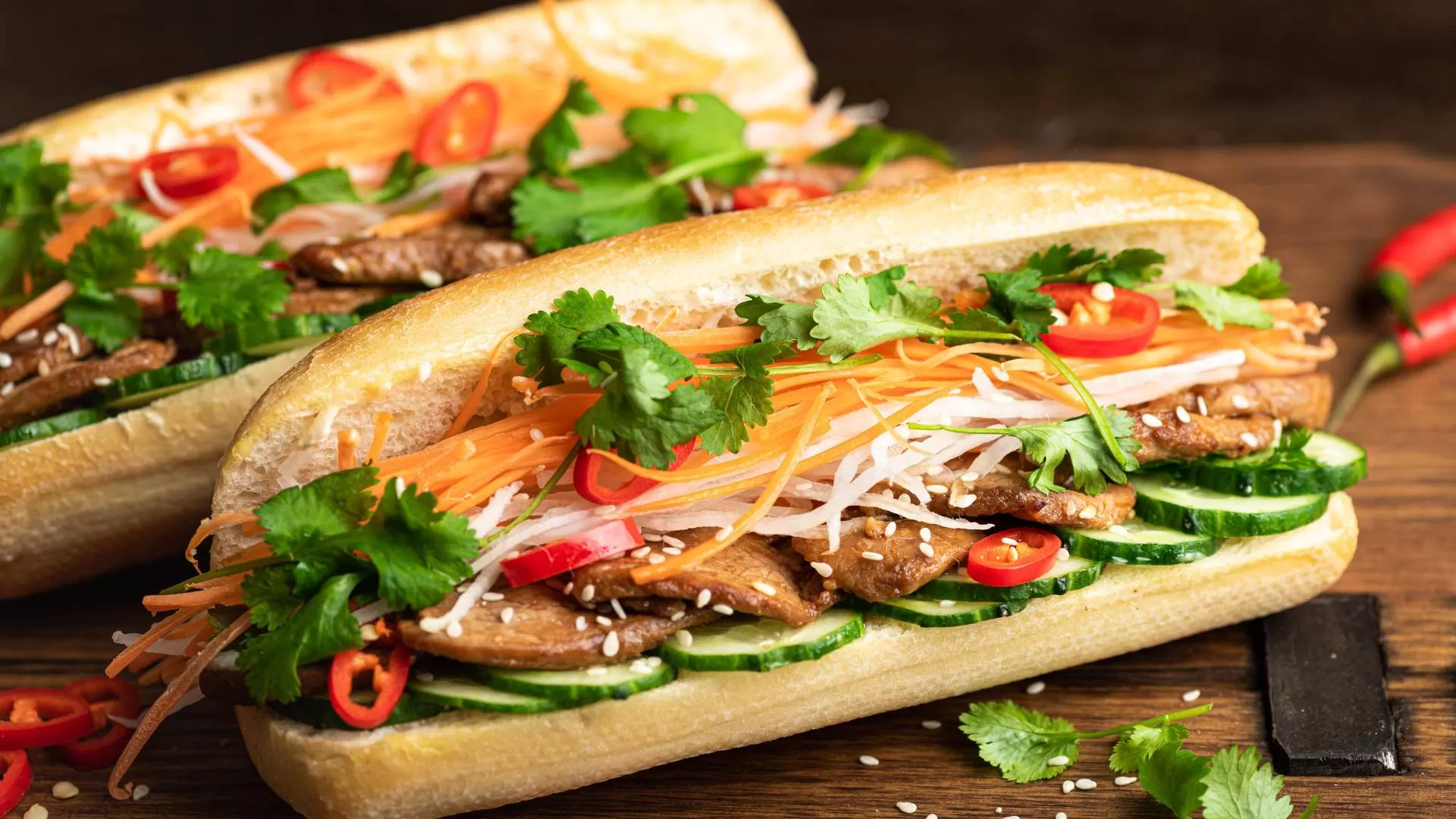
Banh mi, or the Vietnamese sandwich, is one of the most popular street foods in Vietnam that many tourists want to try. Banh mi was introduced to Vietnam by France in the 19th century, inspired by long bread (baguette), then Vietnamese people created additional fillings to eat with it.
Vietnamese bread has many different types of fillings, suitable for everyone’s taste. Fillings such as beef, chicken or pork, pates and vegetables such as carrots, cucumbers, coriander… and spices such as chili and pepper.
Banh mi are often sold at street vendors, sidewalk eateries and local stores. Come to Vietnam and enjoy this wonderful dish.
Bun cha

Bun cha is an outstanding specialty of Vietnam cuisine in general and Hanoi in particular that any tourist should enjoy once when during your Vietnam tour. Although it is a simple Vietnamese dish, it can satisfy any taste buds with its unforgettable flavors. Vermicelli, grilled pork, herbs and fish sauce are all what create the unique flavor of this dish.
When eating this dish, you need to put all the main ingredients in a small bowl and then sprinkle in fish sauce. In particular, the dipping sauce is a blend of chili, garlic, carrots and green papaya. All will bring you a unique sweet and sour flavor that is very suitable for this Vietnamese dish that cannot be found anywhere else.
Bun bo Hue
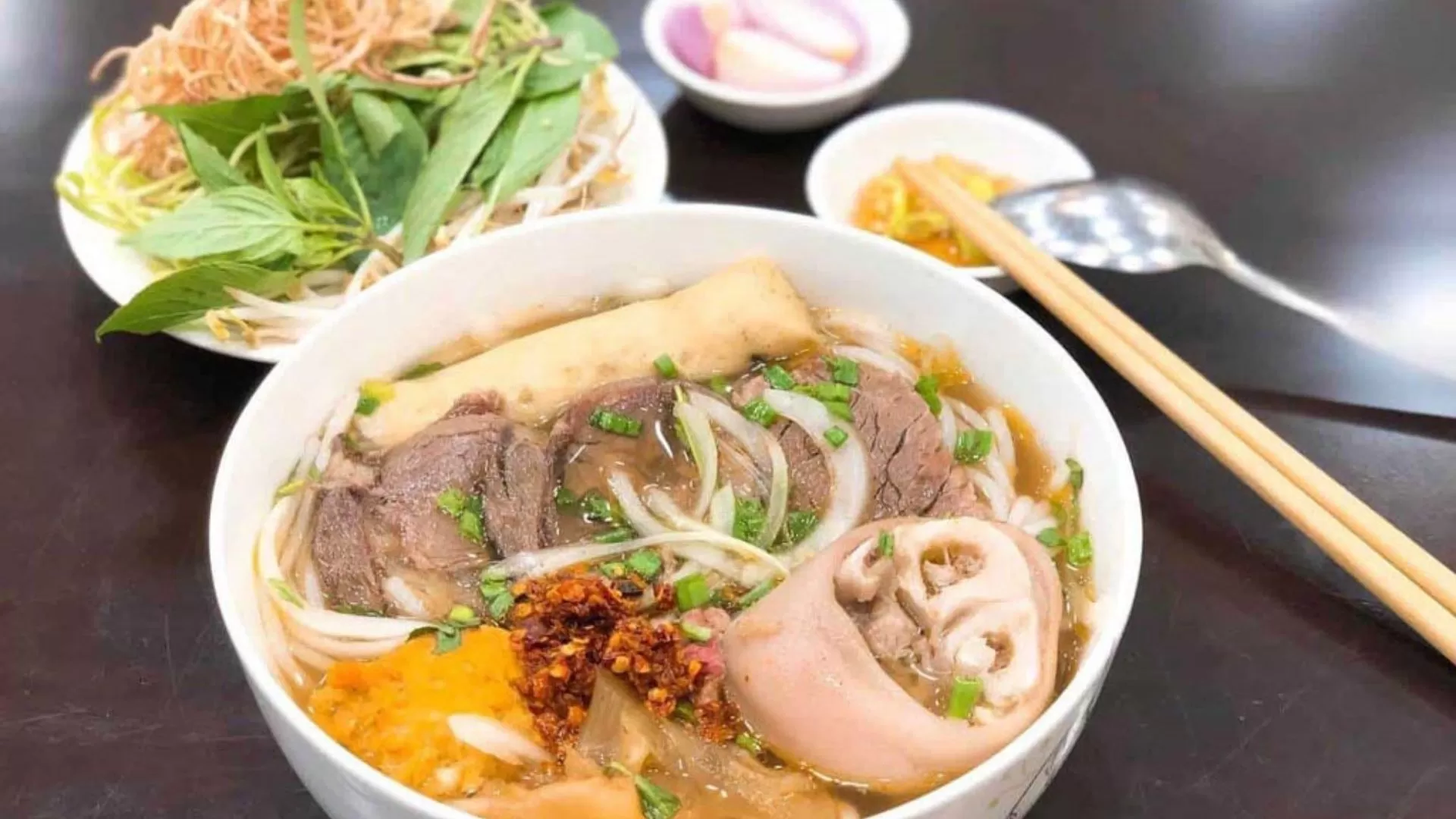
Bun bo Hue is a famous and distinctive Vietnamese dish that originates from the city of Hue, the former imperial capital of Vietnam. This dish is known for its rich, flavorful and spicy broth, and it has become an iconic part of Hue’s and the country’s culinary heritage.
The large vermicelli and thin but large slices of beef, as well as the red-orange broth with an appealing spicy flavor, are the highlights of this Vietnamese dish. To cook this specialty, the chef needs to be meticulous in choosing ingredients and cooking methods.
Cha ca La Vong
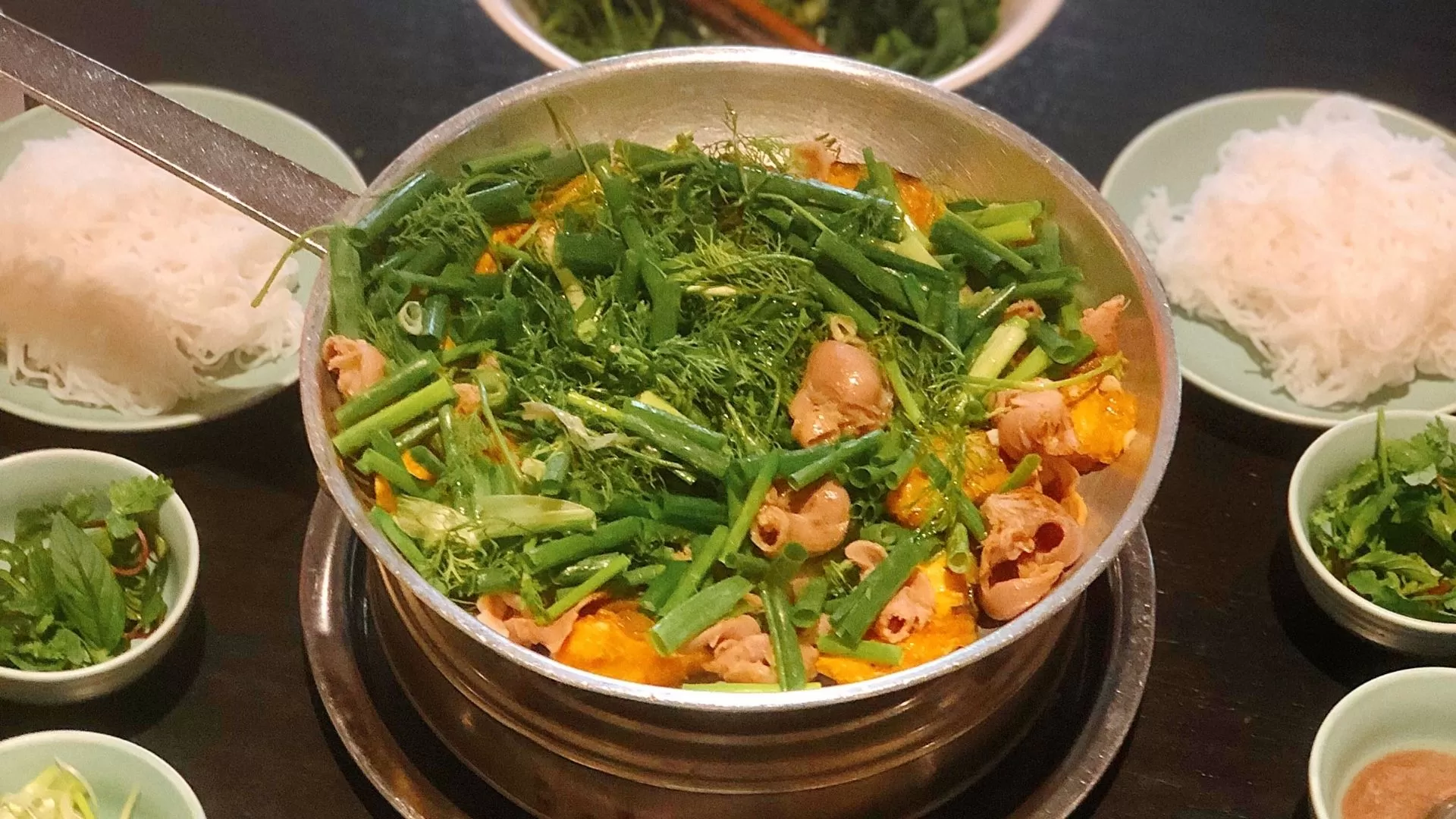
Cha ca is also known as turmeric fish. This dish is an excellent example of the traditional cuisine of Northern Vietnam, and it offers a unique culinary experience with distinctive flavors and deep history. In particular, it is a famous and popular dish in Hanoi, in which white fish is stir-fried in butter with dill and spring onions before being served with rice noodles and a scattering of peanuts.
It’s called Cha ca La Vong because it originated from La Vong restaurant in Hanoi, where this dish has been served since the 19th century. This dish has become an important part of Hanoi cuisine and an interesting part of Vietnamese culinary culture.
Nem ran
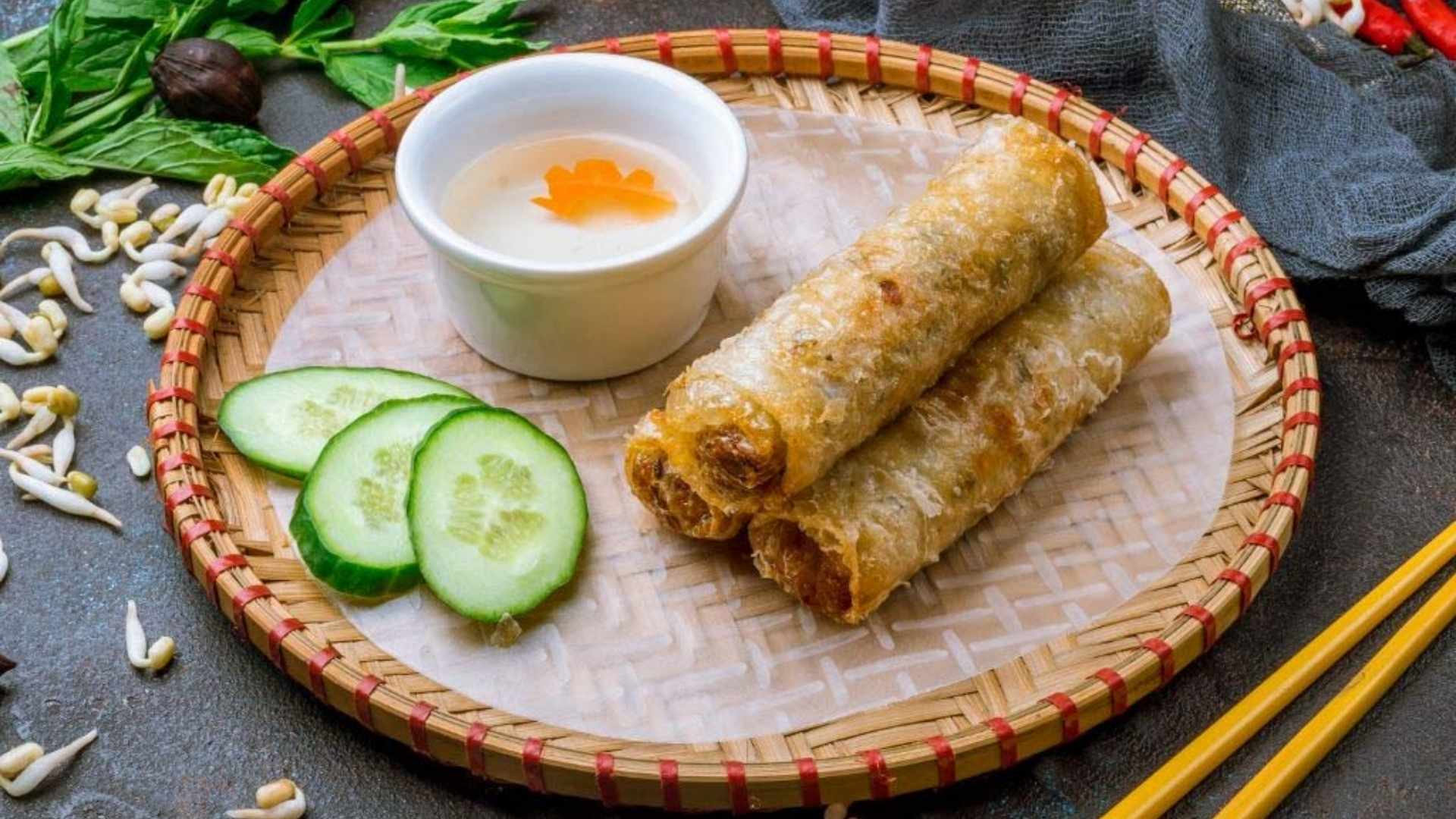
Nem ran, also known as Vietnamese fried spring rolls or cha gio, is a beloved dish in Vietnam cuisine. They’re typically made by wrapping a mixture of seasoned ground pork, minced vegetables (such as carrots, mushrooms and sometimes glass noodles) and spices in rice paper, then deep-frying until crispy and golden brown.
Fried spring rolls are often served as an appetizer or as part of a meal. They’re usually served with fresh lettuce leaves, herbs like mint and cilantro, and a dipping sauce called nuoc cham. It is a popular dish in Vietnam.
Bun dau mam tom
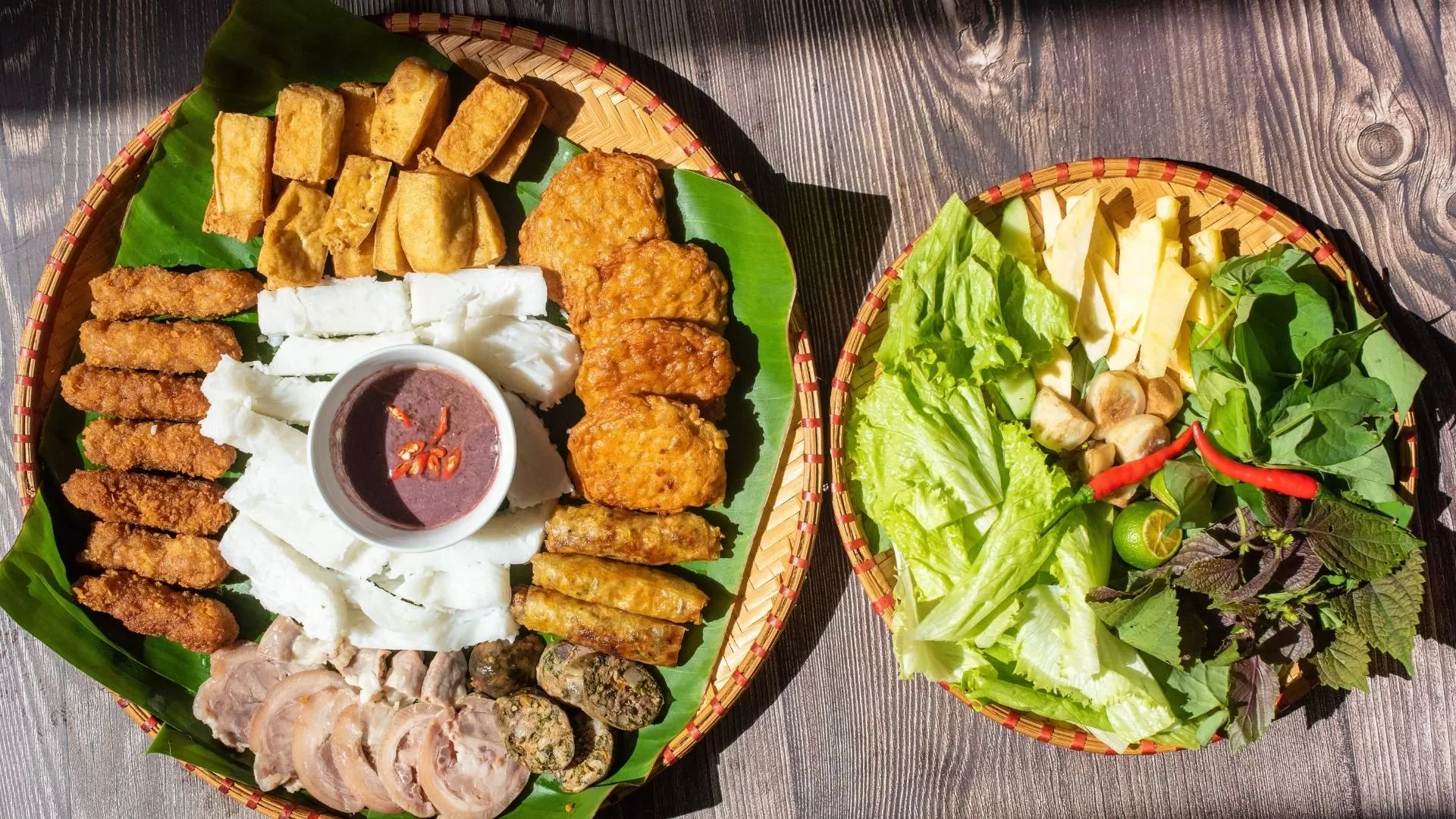
Bun dau mam tom is a popular and distinctive dish in Hanoi, known for its unique combination of flavors and textures. It’s a dish that might challenge the taste buds of some, but it’s beloved by locals and adventurous food enthusiasts.
This dish is typically made up of several components. “Dau” refers to fried tofu and vermicelli rice noodles. Mam tom (fermented shrimp paste dipping sauce) is the dish’s star and perhaps the most difficult part for some palates. Mam tom has a strong, salty flavor and a pungent aroma. To balance its strong flavors, it is frequently combined with lime juice, sugar, garlic and chili.
Bun rieu

Bun rieu is a traditional Northern Vietnamese cuisine originating from the Red River Delta, widely known both domestically and internationally. This dish includes vermicelli and rich crab broth.
Crab broth is a sour soup made from crab bricks, pounded crab meat along with fruit, tomatoes, fat, vinegar, fish sauce, salt and scallions. Shrimp paste is often added when cooking broth to add rich flavor. Bun Rieu is a dish with a sour taste and is very cool to eat in the summer, so it is very popular with Vietnamese people.
Bun thang
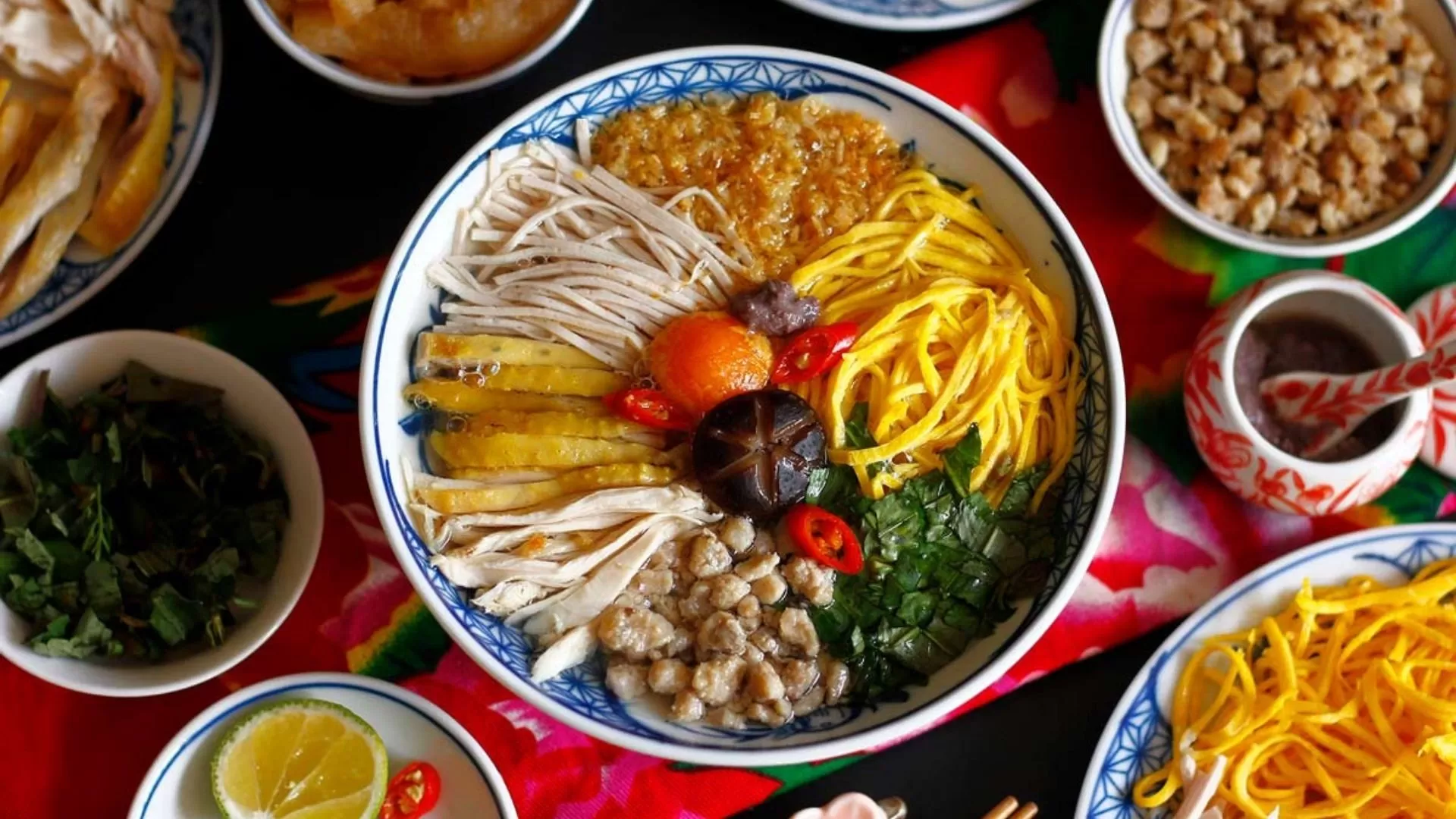
Bun thang is a delicate and visually stunning noodle soup from Hanoi that is often enjoyed as a celebratory dish.
This dish is well-known for its intricate preparation and presentation, which includes thin rice vermicelli noodles immersed in a clear, subtly flavored broth made from chicken or pork bones. Bun thang is distinguished by its colorful and finely sliced toppings, which include shredded chicken, omelet strips, pork sausage (Cha Lua) and wood ear mushrooms.
Banh da cua
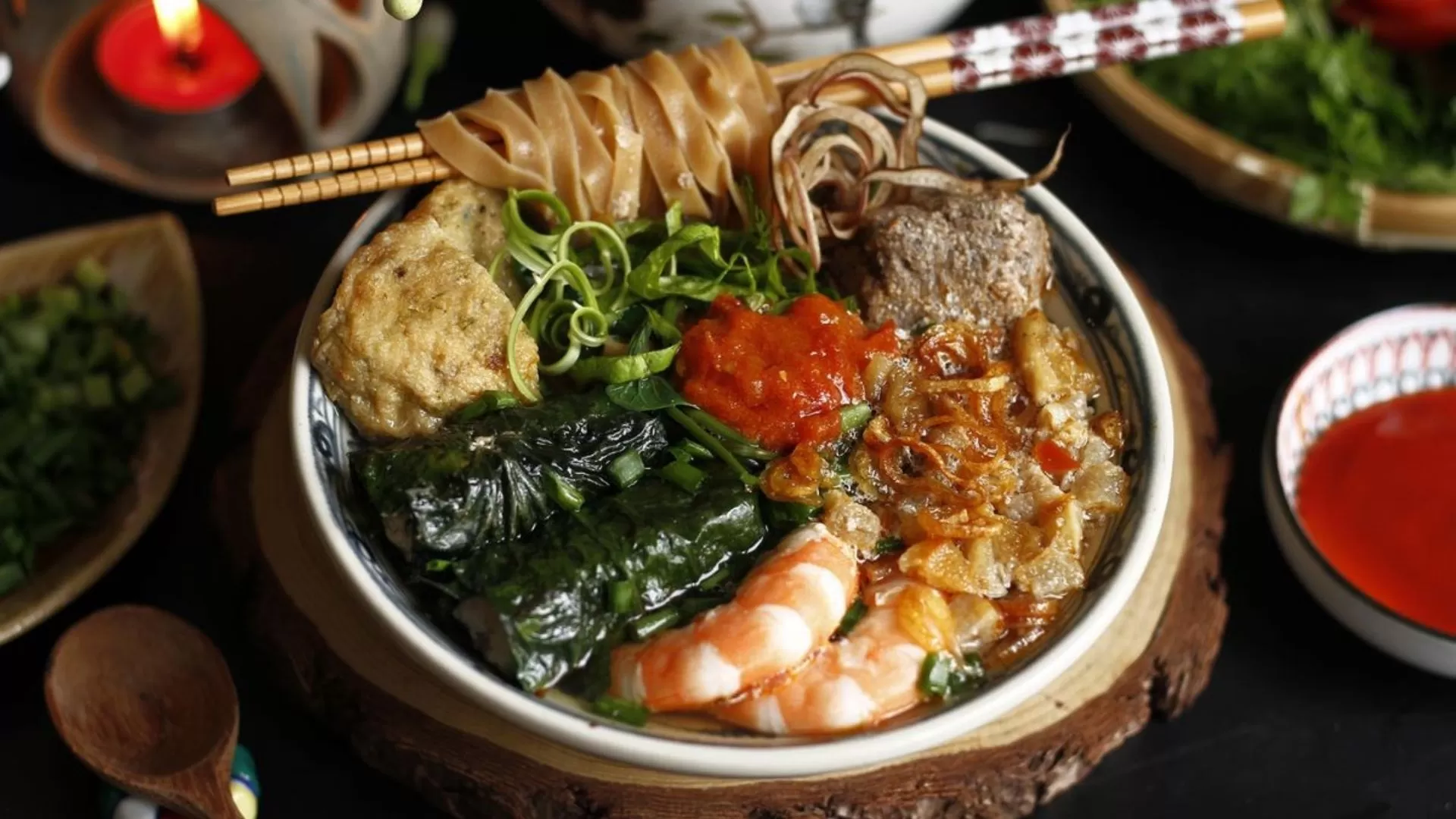
This colorful noodle dish is a specialty from Hai Phong. It includes broth made from pork and a variety of accompanying ingredients such as crab meat, fresh herbs, pork rolls or beef patties.
Ingredients may vary, but each bowl should have a portion of locally made rice paper with its characteristic light red color. A bowl of vermicelli is often served with lemon slices, lettuce, perilla leaves or red chili.
Goi cuon
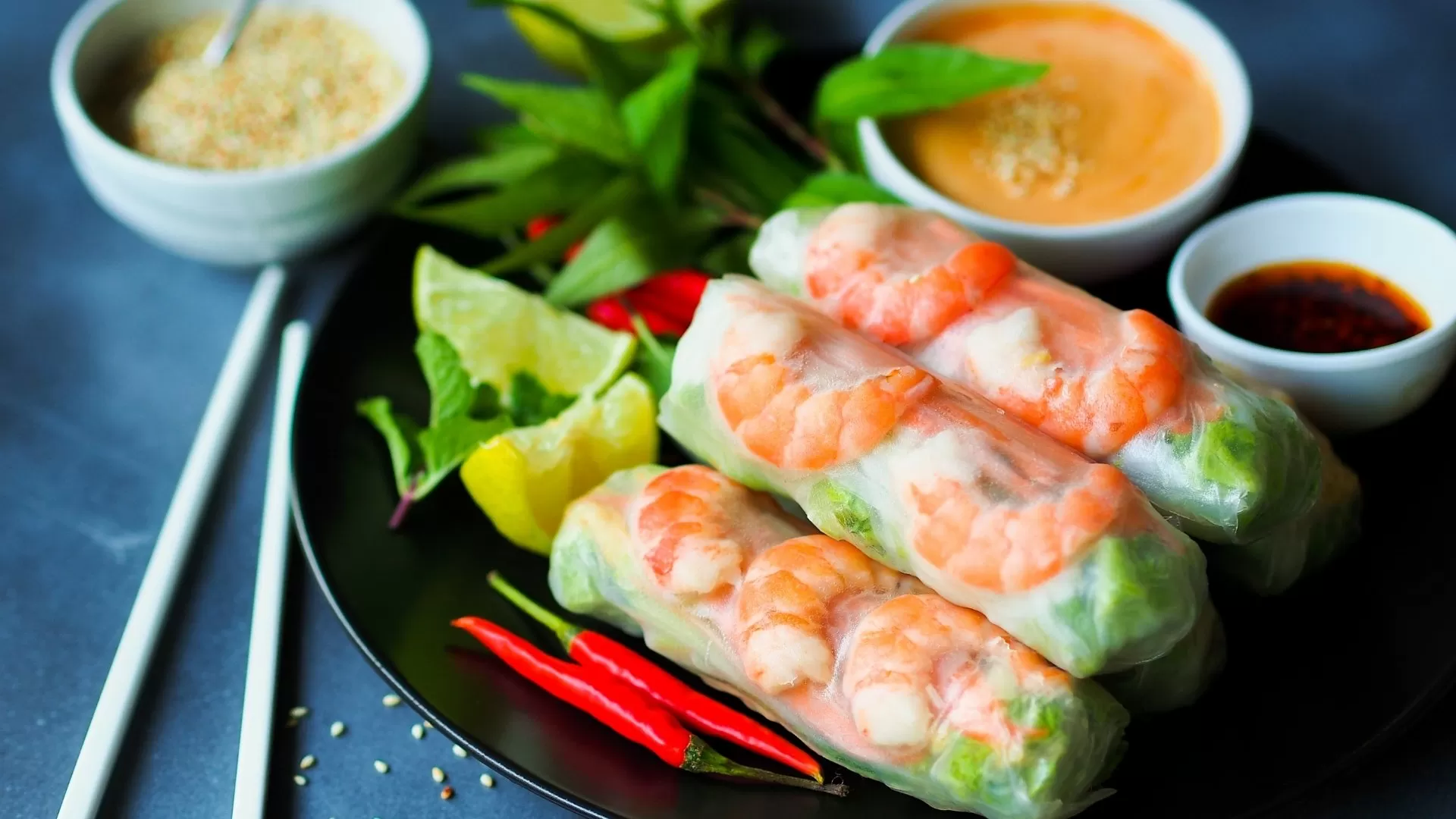
Goi cuon, also known as “spring rolls” in English, is a traditional Vietnamese dish that has also become popular around the world. As a refreshing, low-fat dish, this is a suitable dish for the summer. Spring rolls can have many different fillings. Usually, thin slices of pork with shrimp, lettuce, herbs and vermicelli are tightly wrapped in a thin rice paper and served with sweet and sour dipping sauce.
Learn more: Top 10 Best Vietnamese Street Food
Mi Quang
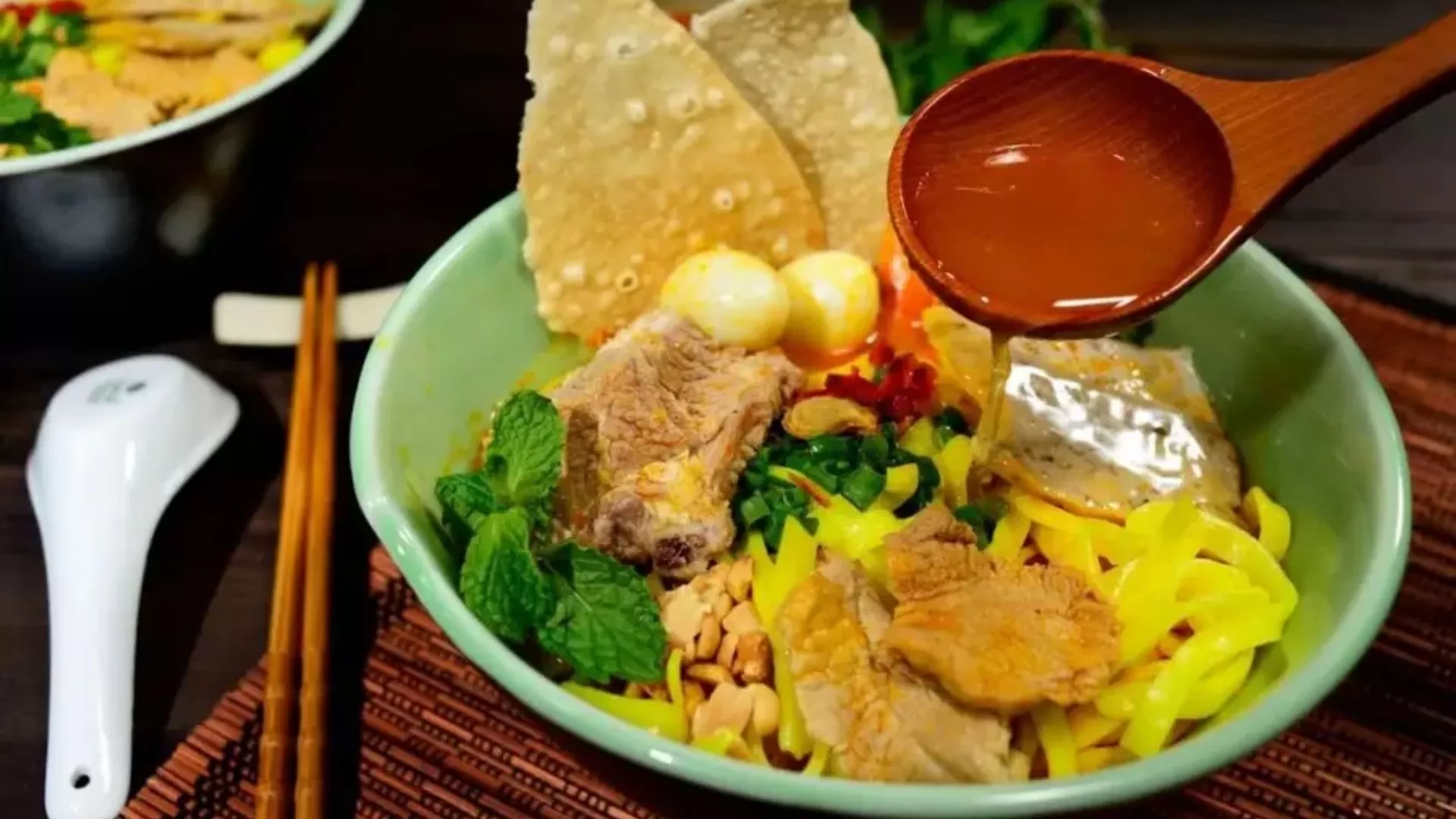
Mi Quang is a distinctive dish from Central Vietnam, originating from the regions of Da Nang and Quang Nam. This dish stands out with its characteristic yellow noodles, made from rice flour and water, creating a unique flavor. Mi Quang is typically served with a variety of ingredients such as shrimp, chicken, or pork and even seafood, garnished with fresh herbs, rice crackers and spices.
The broth for Mi Quang is also special, often made from chicken or pork bones, along with spices like turmeric, scallions, garlic and black pepper. With these key differences in its main components, each version offers you an unforgettable culinary experience.
Cao lau

Cao lau is a typical dish of Hoi An, a famous tourist destination in Central Vietnam. This dish is known for its characteristic brown noodles, made from Hoi An’s special rice, and its flavorful broth. A bowl of cao lau includes Japanese udon-like noodles, roasted pork, herbs, bean sprouts and crunchy croutons. The highlight of this Vietnamese food is the sauce which is uniquely made by the locals. The unique flavor of Cao Lau cannot be found anywhere else, and it has become a culinary symbol of Hoi An.
Banh cuon
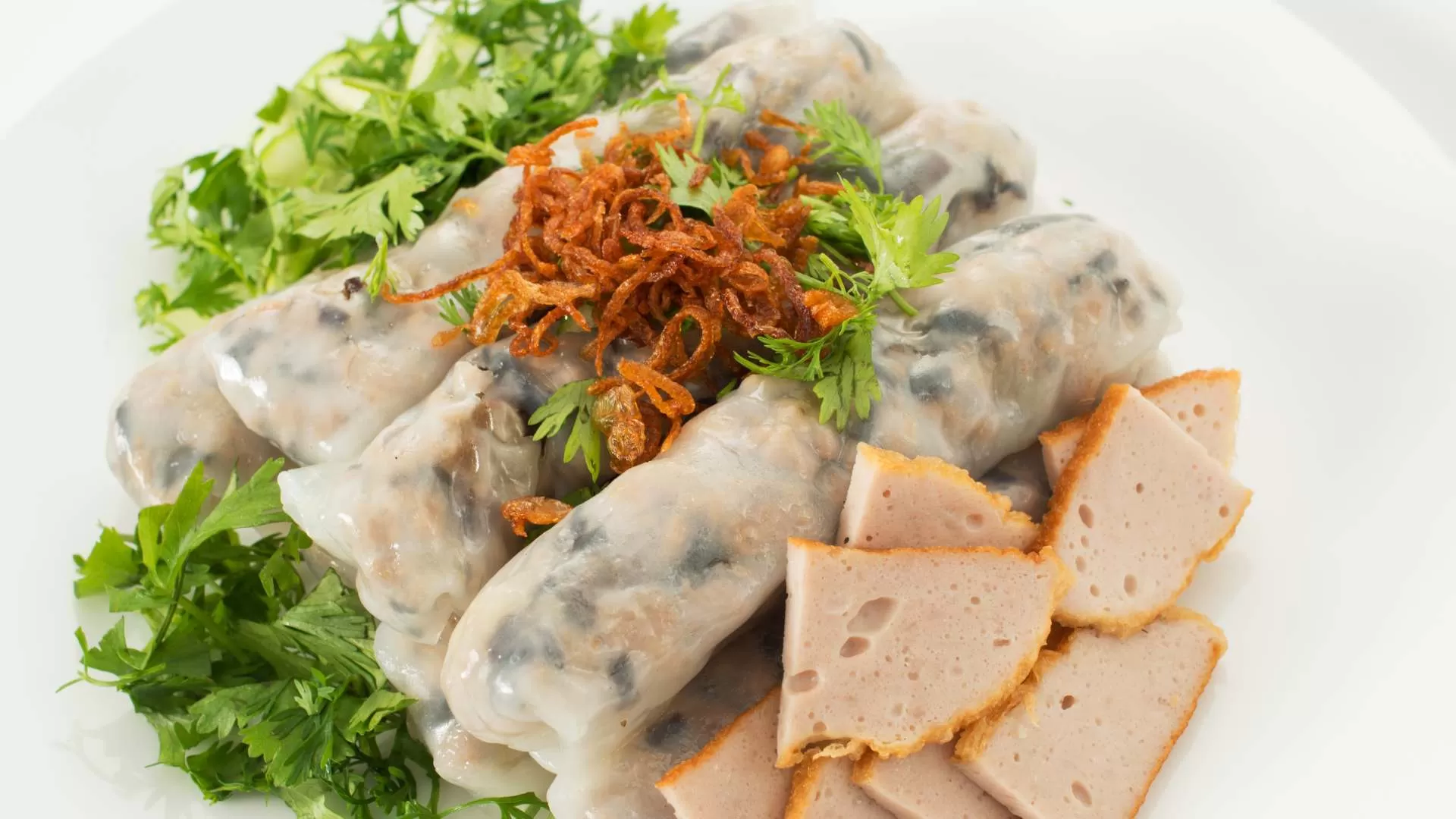
Banh cuon is a Northern Vietnamese cuisine famous for its unique processing skills. This dish consists of a thin roll of rice dough filled with various fillings. What makes banh cuon different is the skill needed to make it, must be as thin as paper but still maintain its elasticity. The filling for banh cuon is usually minced pork or chicken, wood ear mushrooms and shallots.
The key ingredient of this dish is the dipping sauce, usually a mixture of fish sauce, vinegar, sugar and garlic, which adds contrast. The beauty of banh cuon lies in its simplicity, demonstrating Vietnamese culinary expertise in achieving the perfect balance between flavor and texture.
Banh xeo

Banh xeo makes the first impression on diners with its thin, crispy, golden outer shell. Depending on the region, the filling will have different ingredients, but the filling for Banh Xeo is mainly a combination of fresh shrimp, delicious pork and bean sprouts.
You can roll Banh xeo with rice paper, raw vegetables, cucumber and dip it with the signature sweet and sour dipping sauce. The harmonious blend between the crispiness of the crust and the aroma of each piece of meat, shrimp, and spices makes the dish irresistible.
Banh beo
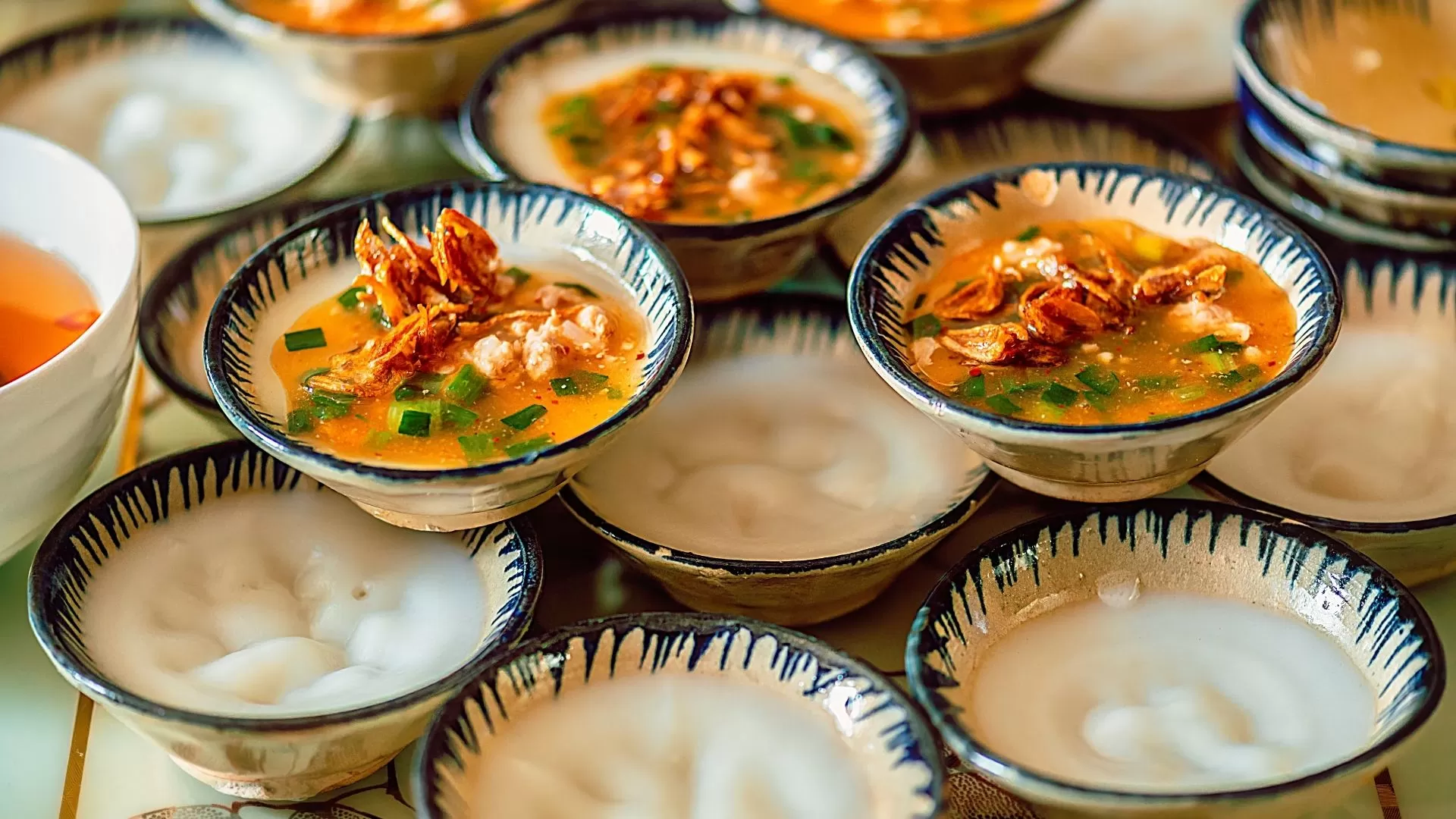
Banh Beo is a dish with a rustic yet no less sophisticated flavor in the diverse culinary world of Vietnamese street food. Banh Beo is usually made from steamed rice flour, served with layers of fresh filling and delicate dipping sauce.
The fillings of banh beo are rich and diverse, varying by region: they can be peanuts, pureed shrimp, minced pork and many other fillings. Each type of filling has its unique flavor, making Banh Beo an unforgettable delicacy in the hearts of diners.
Banh khot

Banh khot is a popular Vietnamese dish that consists of small, crispy and savory pancakes made from rice flour, coconut milk and turmeric.
Traditionally, banh khot is filled with a combination of shrimp, spring onions and sometimes mung beans or other ingredients, depending on the region. The dish is often served with fresh lettuce leaves, herbs like mint and Vietnamese perilla, and a side of nuoc cham dipping sauce made with fish sauce, lime, sugar, garlic and chili. It’s a delicious and flavorful snack or appetizer that showcases the diversity of Vietnam cuisine.
Com hen
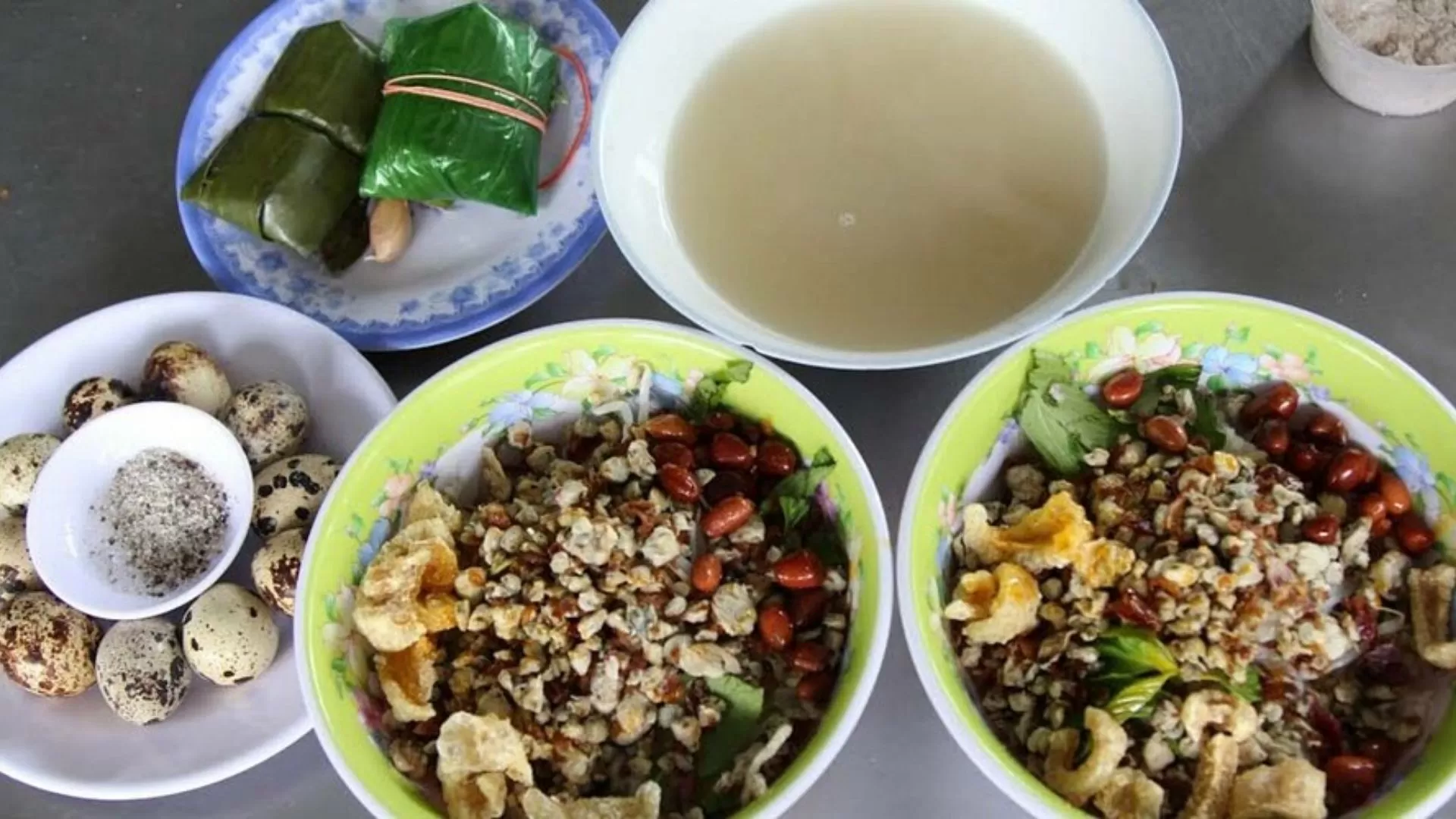
Com hen is a Vietnamese dish that originates from the central region, particularly in Hue. It consists of a flavorful mix of rice topped with baby clams (hen), accompanied by a variety of herbs, vegetables and a tangy, spicy sauce.
The dish is served with a variety of fresh greens like shredded banana flowers, starfruit, basil and perilla leaves, providing a medley of tastes and textures.
Xoi
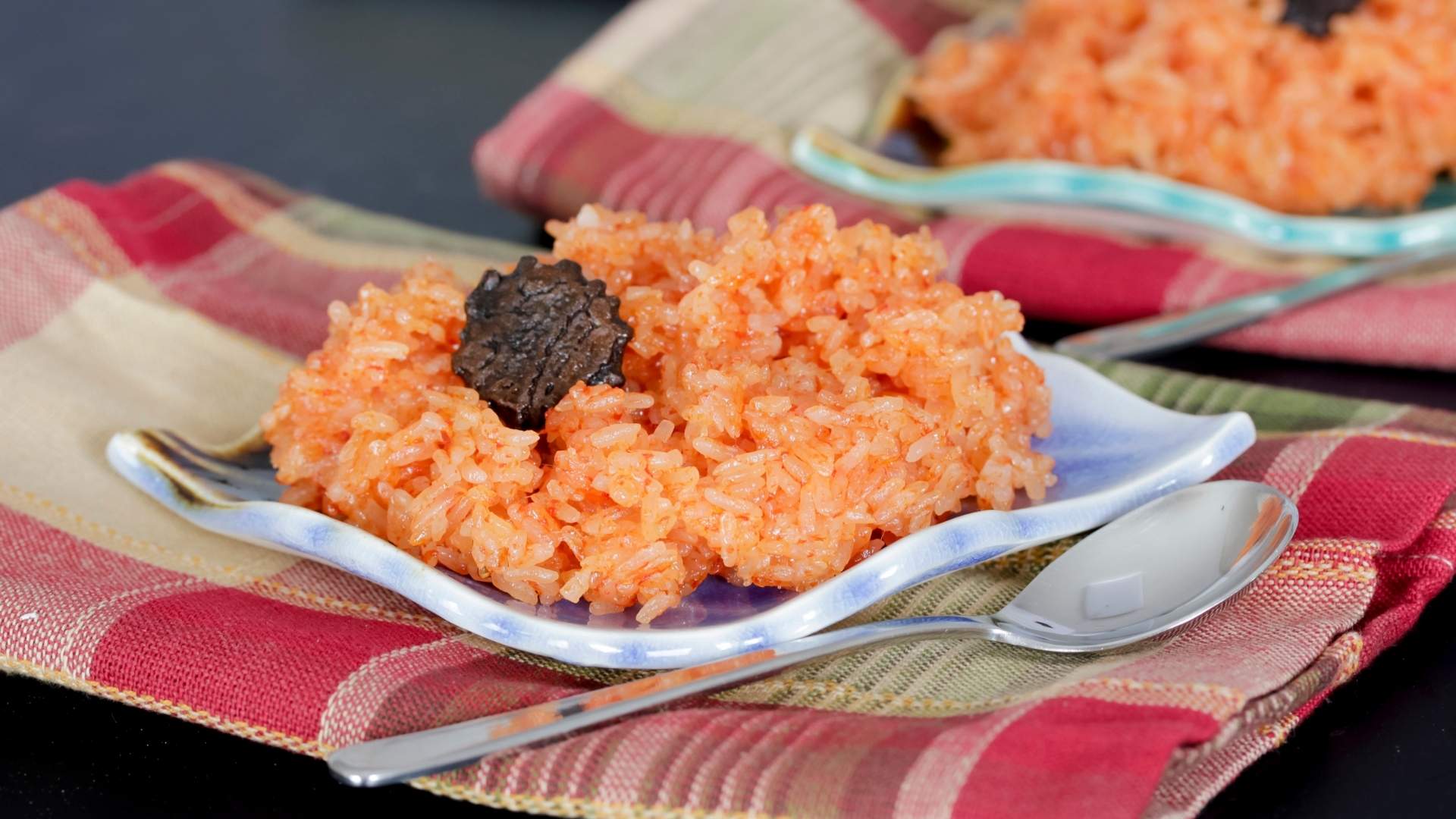
Xoi, known as “sticky rice” in Vietnamese, holds a significant place in Vietnam cuisine and culture. There are some common types of Xoi in Vietnam. Xoi Xeo is the yellow-hued sticky rice, which is typically cooked with turmeric. It’s often served with mung bean paste and topped with fried shallots. Another type is Xoi Gac. Bright red, xoi gac is made with the aril of the gấc fruit, giving it a slightly sweet taste. It’s often served during special occasions like Tet (Lunar New Year).
Com tam
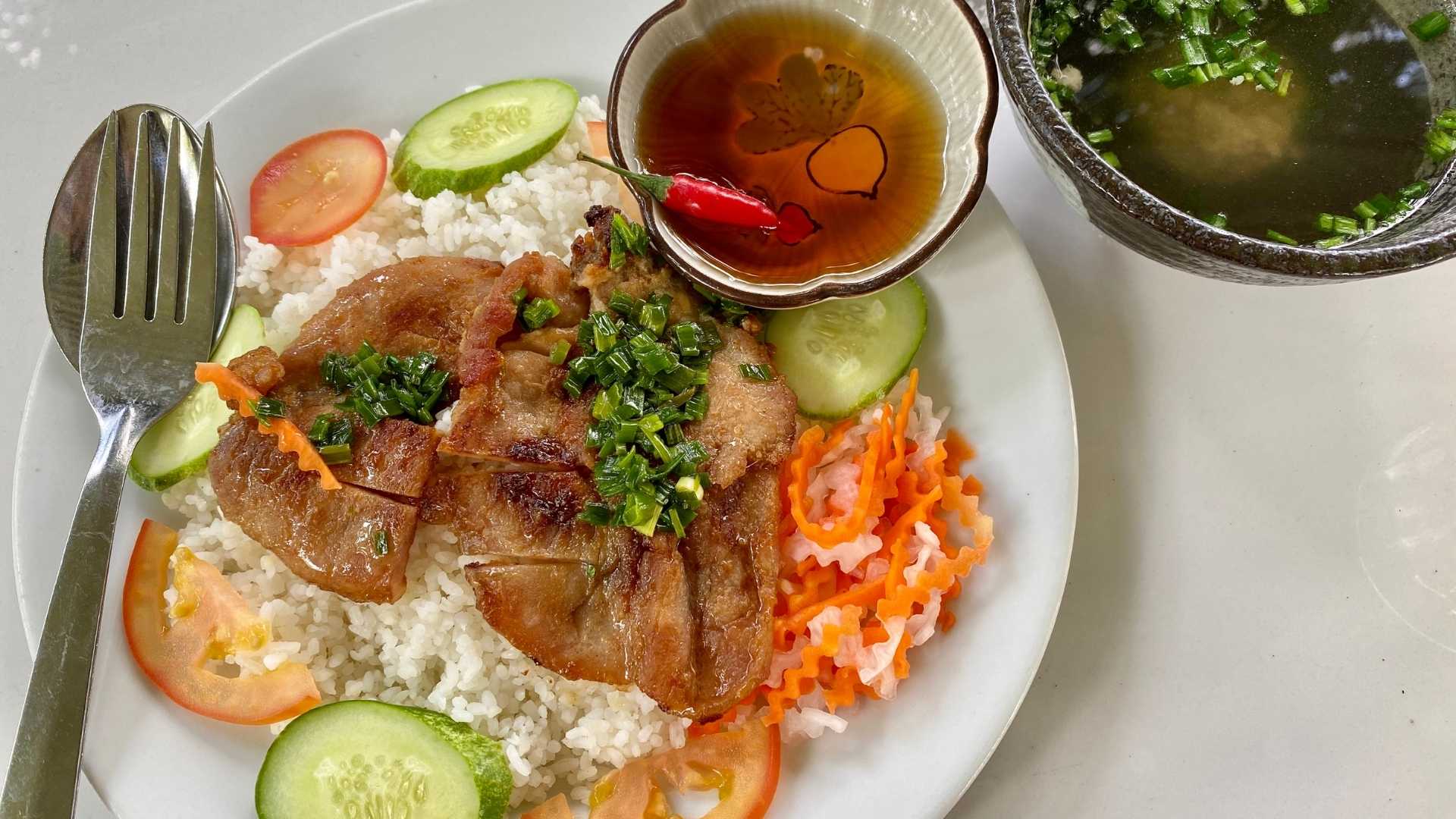
Com tam, also known as broken rice, is a famous and popular dish in the South, especially in Ho Chi Minh City. This dish is made from very simple ingredients but creates a unique flavor that is difficult to mix with any other rice dish.
It is prepared from broken rice grains and has a delicious taste and unique aroma. A traditional plate of broken rice includes rice, grilled pork chops, shredded pork skin, fried eggs and dipping sauce.
If you have the opportunity to have a Vietnam Holiday, don’t miss the opportunity to try the delicious and unique broken rice dish. The distinctive flavor, meticulous preparation and variety of ingredients make broken rice an important part of Vietnam cuisine.
Bo kho
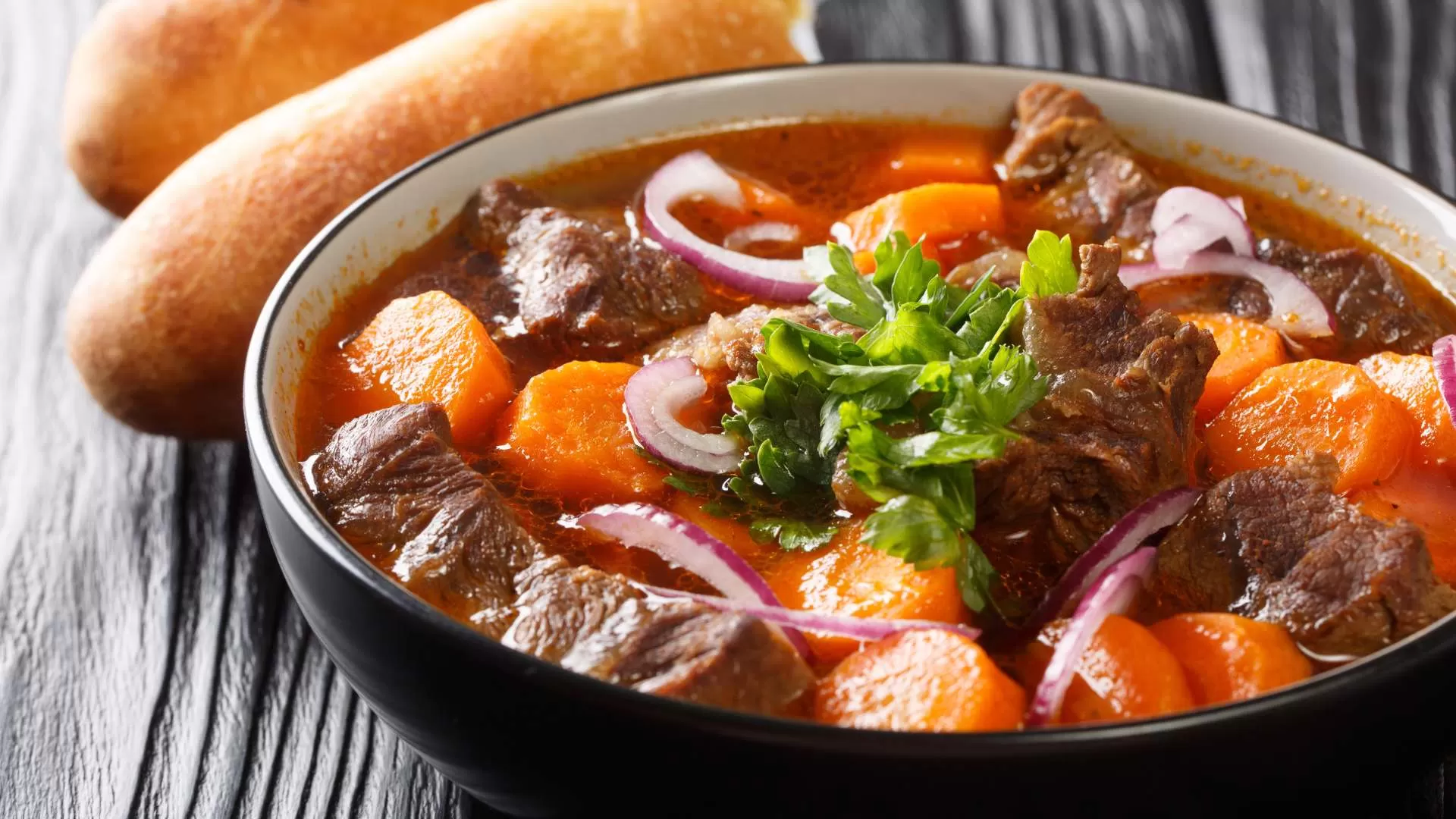
Bo kho is a flavorful and hearty Vietnamese beef stew that’s a beloved comfort food dish. Bo kho typically includes beef (often brisket or shank) simmered in a flavorful broth made with lemongrass, garlic, shallots, tomato paste, fish sauce, star anise, cinnamon, cloves and sometimes curry powder or annatto seeds for color.
Along with the beef, carrots, potatoes, and sometimes onions are added to the stew, enhancing its richness and texture.
Cha ruoi
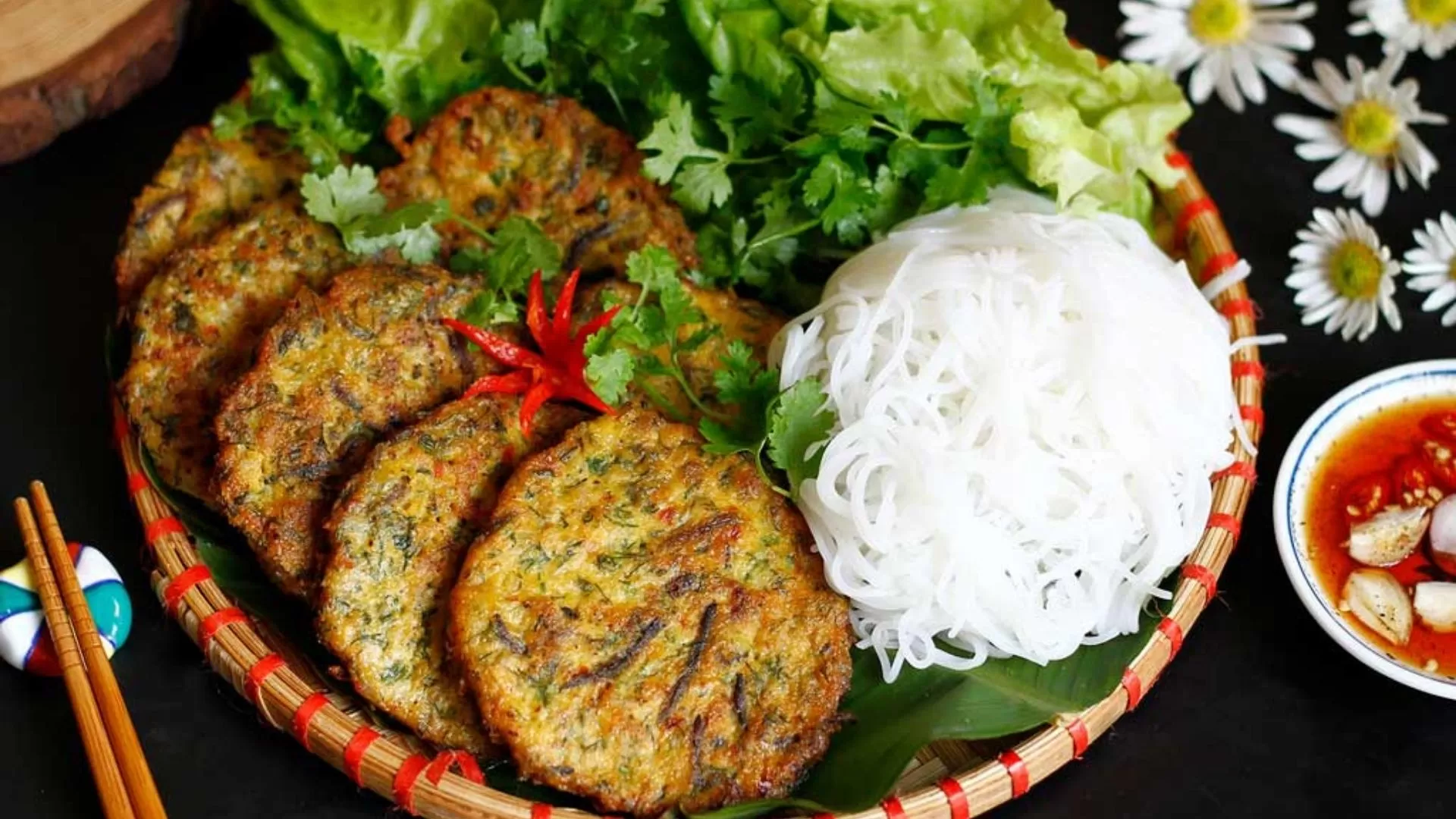
Cha ruoi is a Vietnamese dish made from ruoi, which are tiny, red and flavorful sand worms found in the muddy areas of rice paddies during the flooding season.
The preparation of cha ruoi involves cleaning the worms thoroughly, removing any impurities or mud. Once cleaned, the ruoi are mixed with various ingredients such as ground pork, garlic, shallots, fish sauce, pepper and sometimes egg to create a flavorful paste or mixture and then fried for a crispy texture. Its distinct flavor and crispy texture make it a desirable dish.
Lau (hotpot)
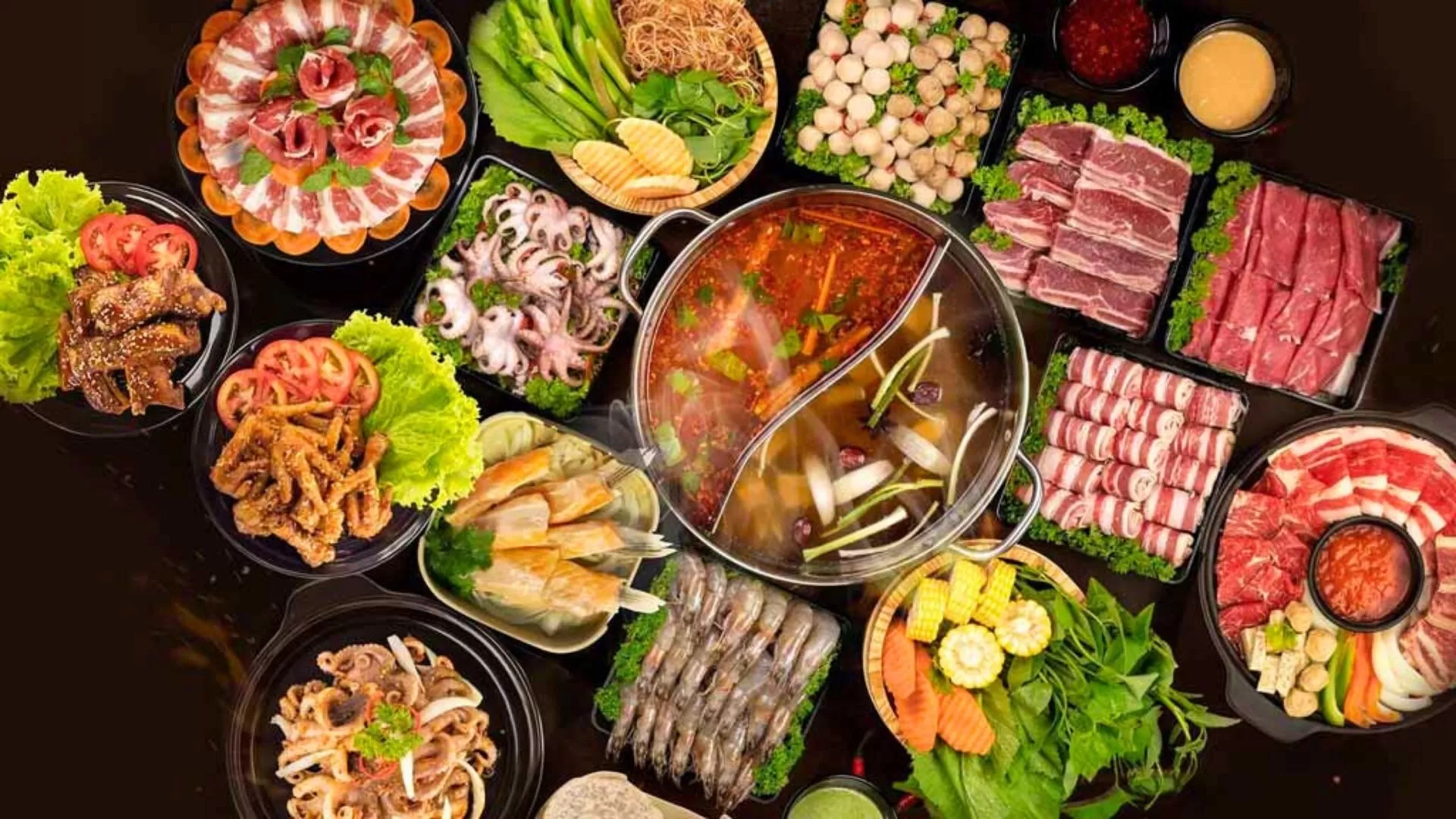
Hotpot in Vietnam, known as “lau”, is a beloved communal dining experience. It involves a pot of simmering broth placed on a portable stove in the middle of the table. Diners add a variety of fresh ingredients like thinly sliced meat (beef, pork, chicken), seafood (shrimp, squid, fish), vegetables (bok choy, mushrooms, tofu) and noodles.
Vietnamese hotpot broths can vary widely in flavors, ranging from clear and mild to spicy and bold. It’s a popular dish in which friends and family gather, share food and enjoy the interactive dining experience together.
Hu tieu
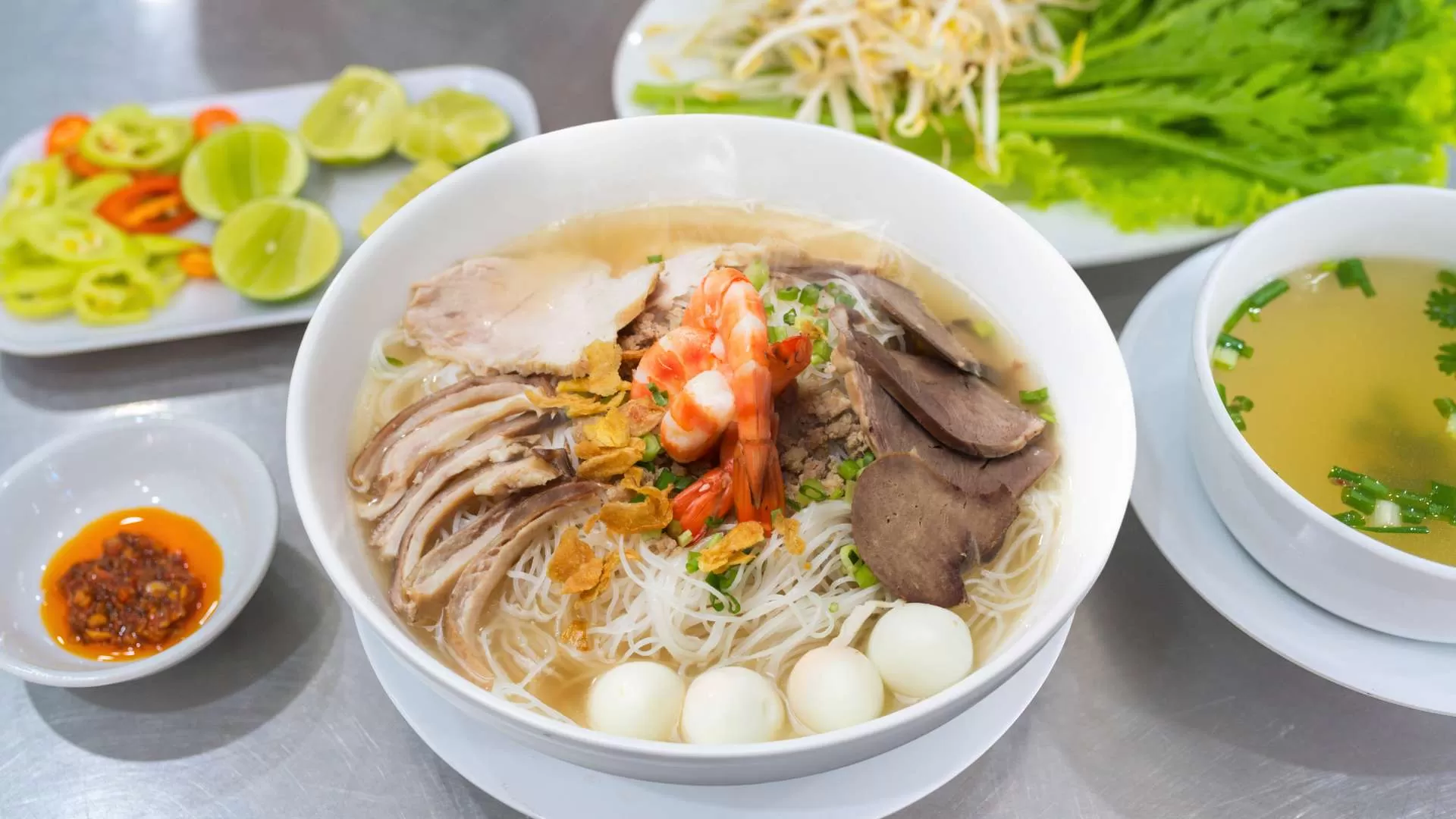
Hu tieu is a popular Vietnamese noodle dish that has various regional variations across Vietnam. The dish originated from the southern part of Vietnam, but it has become popular throughout the country.
It typically consists of thin rice noodles (similar to pho noodles) served in a flavorful and aromatic broth with a variety of toppings. It can vary widely depending on the region and personal preferences. It’s often served with fresh herbs, bean sprouts, lime wedges and sliced chilies on the side, allowing diners to customize the dish according to their tastes.
Com lam
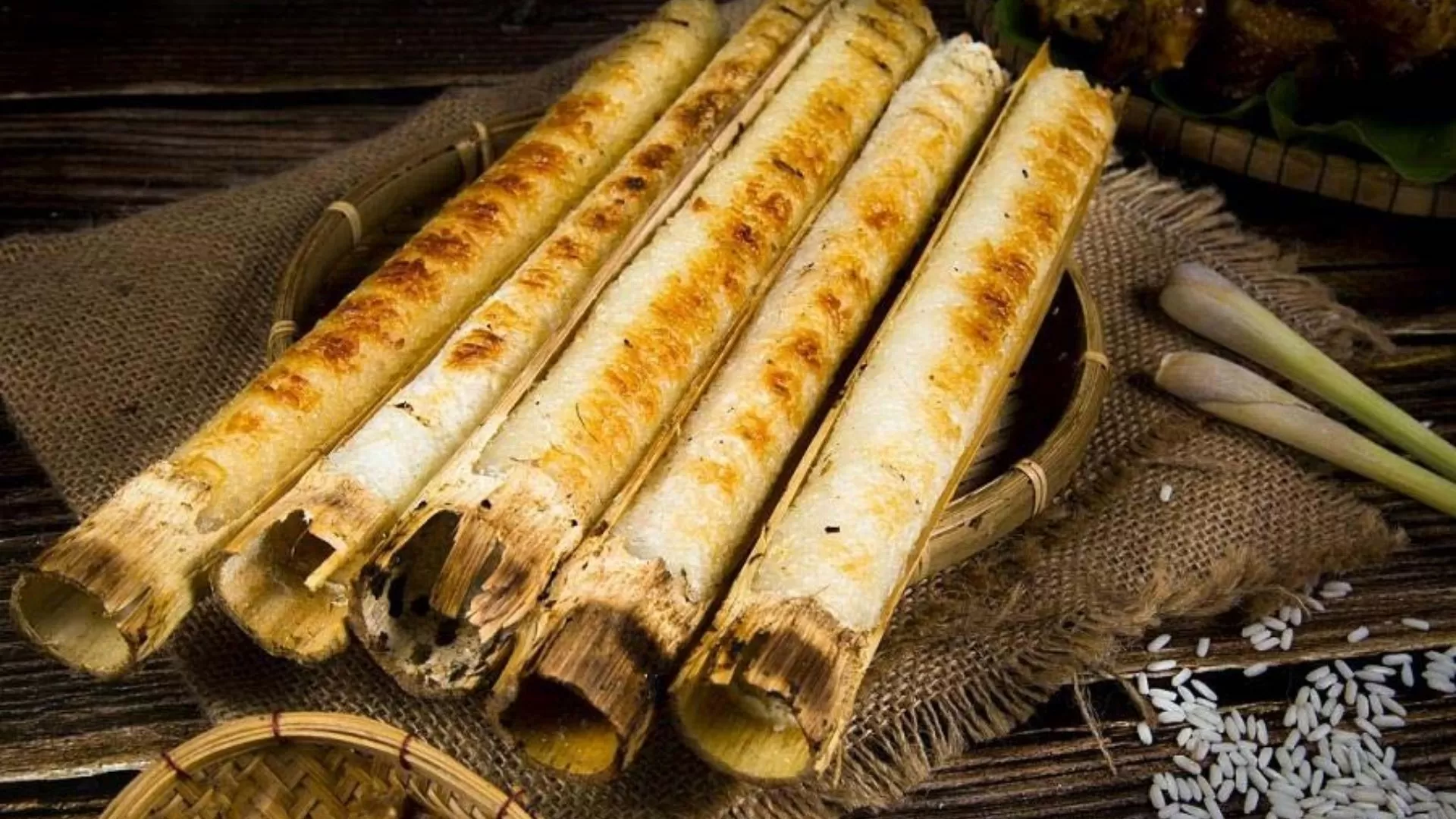
For people in the North, Com lam (bamboo sticky rice) is a Northern Vietnamese cuisine that has a special place in everyone’s heart. Com lam represents the quintessence of Northern Vietnamese cuisines through the unique cooking method, sticky rice is wrapped in bamboo tubes and cooked slowly over a fire, bringing excitement to sticky rice dishes through its amazing smoky flavor.
You can enjoy the taste of Com lam with Vietnamese rice wine to take the flavor to a new level. The dish often comes with a bowl of salt and sesame or cham cheo – a special dipping sauce of Northwest people.
Sup luon
“Sup luon” is a Vietnamese dish that translates to “eel soup.” This dish features eel as the primary ingredient and is prepared in various styles across different regions of Vietnam.
Typically, eel is simmered or cooked in a flavorful broth along with various herbs and spices, creating a savory and aromatic soup. The eel is often cut into bite-sized pieces and added to the soup, allowing it to absorb the flavors of the broth.
Banh canh cua
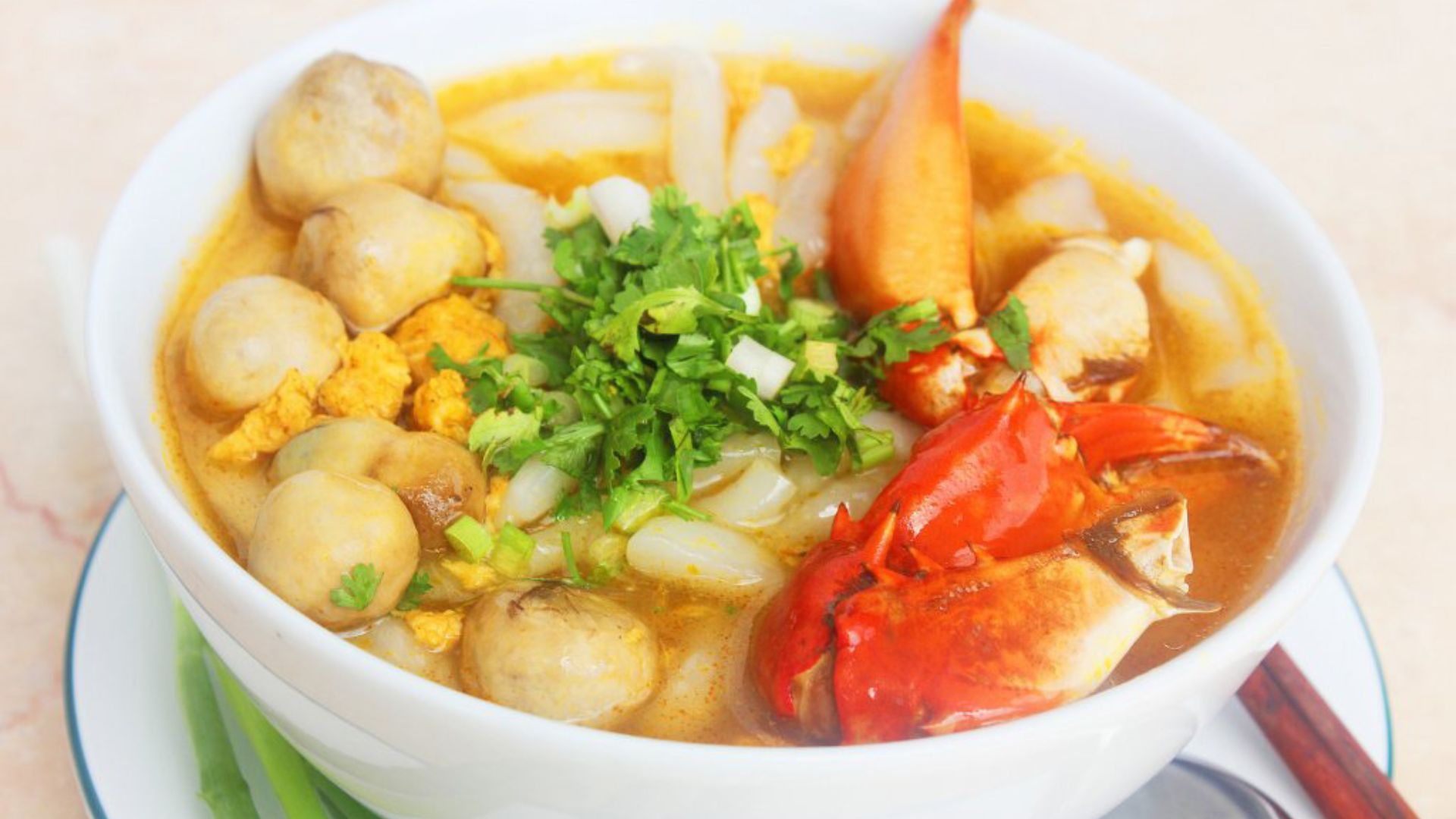
Banh canh cua is a Vietnamese dish known for its thick noodles made from tapioca or rice flour, served in a flavorful broth with crab meat. Banh canh noodles are thicker and chewier compared to other Vietnamese noodles like pho or bun. The dish is topped or mixed with pieces of crab meat or sometimes whole crab claws, providing a sweet and savory element to the soup.
Banh canh cua is often garnished with fresh herbs like cilantro, sawtooth herb, or Vietnamese coriander, along with a squeeze of lime for added freshness.
Cha muc Ha Long
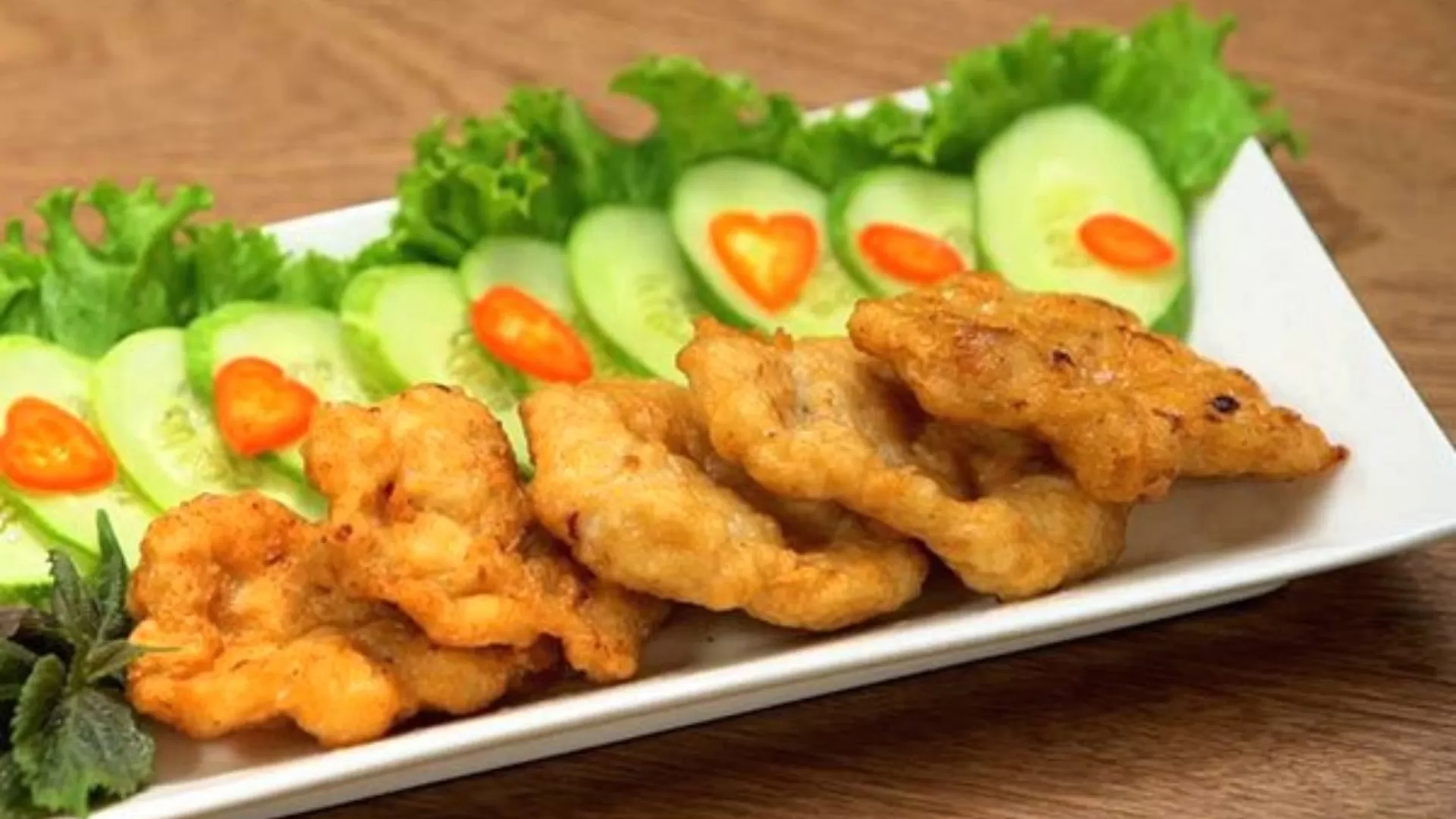
Cha muc is a Vietnamese dish and “Ha Long” refers to a specific style or origin of this dish. Cha muc Ha Long is made by pounding or grinding squid meat into a paste and mixing it with various seasonings like garlic, shallots, fish sauce, sugar, pepper and so on.
The dish is often served with fresh herbs, lettuce leaves and a dipping sauce, such as a mix of lime juice, salt, pepper and sometimes chili for a bit of heat.
Egg coffee
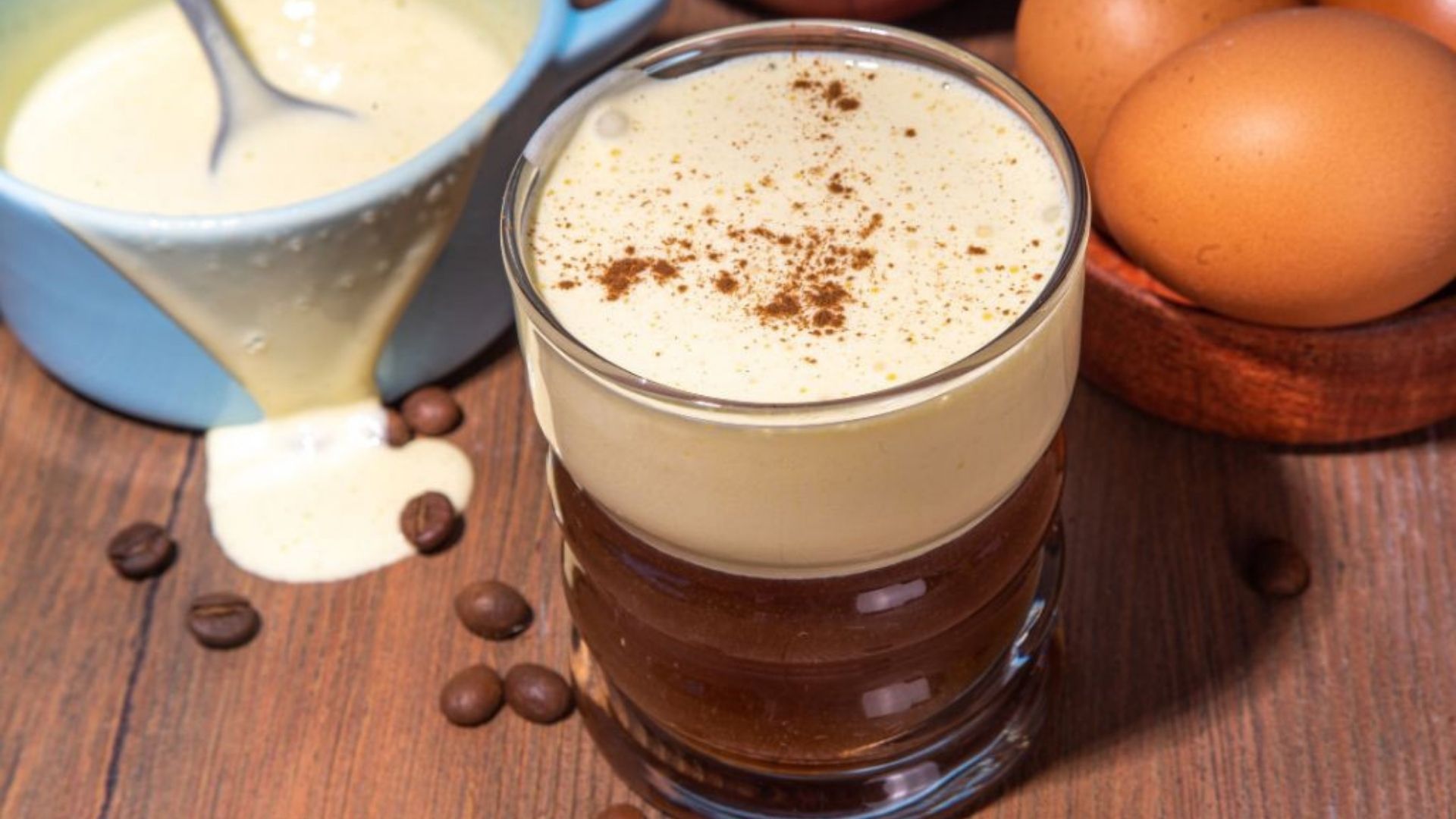
Egg coffee is made from beaten eggs mixed very skillfully with coffee, so that hot coffee is poured into the beaten eggs, creating a beautiful and fragrant layer of foam. Diners always have an extra spoon to enjoy the cream foam on top like an appetizer before drinking coffee below. The delicate combination of the sweetness of the egg cream combined with milk dissolves the bitter taste of coffee and leaves only a sweet, attractive aroma.
Che - Sweet soup
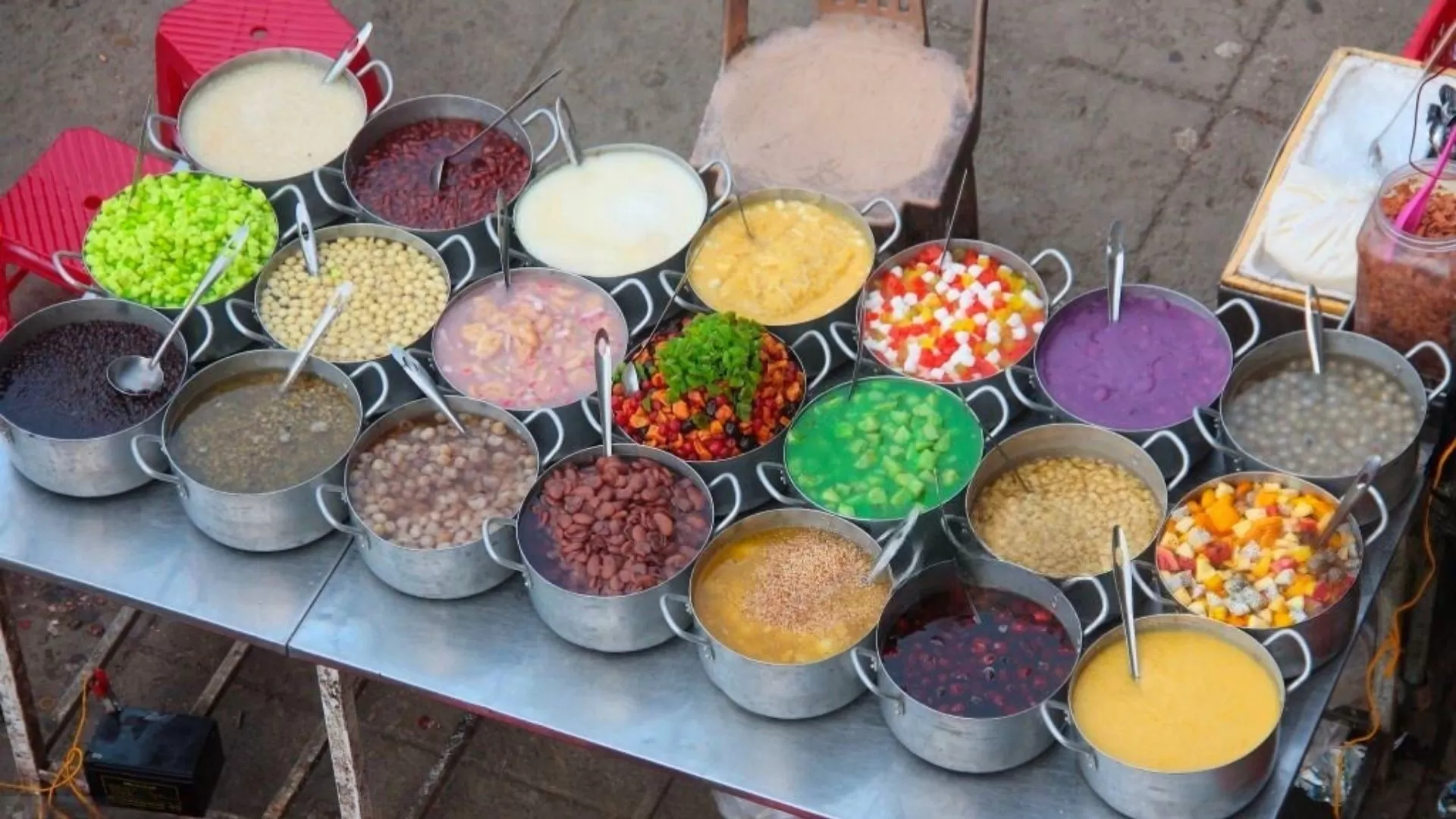
Che is a typical and long-standing dessert of Vietnam. Sweet soup can be made from many types of seeds such as green beans, taro, or pandan leaves and even fruit. This dish has many different variations. In the past, simple sweet soup dishes were only lotus sweet soup, black bean sweet soup, and green bean sweet soup to cool down on hot summer afternoons. In addition, hot sticky rice and sweet soup are also delicious drinks for a cold afternoon.
These dishes represent just a fraction of Vietnam’s diverse and delicious cuisine. Each region has its specialties, so exploring local markets and street food stalls can lead to discovering even more culinary delights. If you have the opportunity to have a Vietnam holiday, don’t forget to discover top Vietnamese foods that Hanoi Voyages has suggested for you to explore with your friends every corner of Vietnam’s streets.
Dream about your trip to Asia, in private
We are here to make it happen with youFREE QUOTE, WITHOUT OBLIGATION









.webp)






